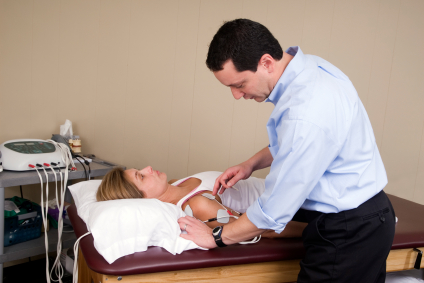

The mechanism of injury can be interpreted by asking about the mode of injury such as fall by asking about the mode of injury ,such as fall from height, road traffic accident, position of the limb or body at the time of injury, any rotational force acting on the body and the type of activity done by the time of injury.
The mechanism of injury, site of injury, pain and disabilities should be interpreted from the history.
Examination
Inspection: The patient should be examined in sitting position with his upper torso and upper limbs exposed upto the waist.
Attitude: The position of the limb on inspection should be noted. In fractures of clavicle and anterior dislocation of shoulder, the patient often supports the injured limbs with the other hand. The arm segment may appear short or long depending on in fracture neck of scapula, there will be lengthing of the arm.
Swelling or deformity: In anterior dislocation of shoulder, the anterior axillary fold may be abnormally prominent due to the presence of head of humerus. A swelling along the line of clavicle, diffuse swelling surrounding the proximal humerus may be seen in fractures of the underlying bones. The lateral end of clavicle may appear to be prominent in acromioclavicular joint injuries. The medial end of clavicle may be seen prominently in sternoclavicular injuries.
Shoulder contour: Normally, the shoulder has a round contour due to prominence of the greater tuberosity beneath the deltoid muscle. The greater tuberosity projects beyond the edge of acromion process giving the normal contour. In dislocation of the shoulder joint, due to loss of projection of greater tuberosity, the normal contour will be lost. This is a valuable sign of dislocation. In deltoid paralysis due to axillary nerve injuries, there may be wasting of the muscle causing apparent loss of contour of the shoulder. The shoulder contour may be masked by diffuse swelling associated with fractures of the proximal humerus.
Bony arch: The bony arch is formed by the clavicle, acromion process and spine of scapula. Any deformity in the bony arch should be noted for.
Palpation
The bony points to be palpated are: clavicle, proximal humerus, acromion process, spine and borders of scapula for signs of fracture.
Clavicle: By standing behind the sitting patient, the examiner places both his hands on the medial end of clavicle and runs his fingers along the shaft of both the clavicles. Any irregularity, gap or crepitus should be looked for. In acromioclavicular joint dislocation, the lateral end of clavicle may be displaced upward. On pressing the lateral end of clavicle, it depresses and bounces back like a piano key.
Proximal humerus: By standing on the side of the patient, the elbow is flexed and the proximal humerus is palpated bimanually by keeping one hand and the medial surface of arm and other on the outer surface of the arm. By standing behind the patient, the examiner slides his fingers down from the acromion process to the arm to palpate the greater tuberosity and proximal humerus. If the head of humerus is in normal position, then there will be a bony resistance to palpation. In dislocations, there will be an empty feeling in the shoulder region. The head may be palpable in either of axillary folds. Diffuse tenderness may be present in fractures of proximal humerus. In an intact humerus, the medial epicondyle will be in the same direction as that of the head of humerus.
Scapula: The acromion process and spine of scapula are palpated for irregularity, bony tenderness and crepitus. The axillary and vertebral borders are palpated for signs of fracture. The coracoids process is situated half an inch below the clavicle at its junction with medial two third and lateral one third. Fracture neck of scapula is diagnosed by axial pressure applied through the arm with the elbow flexed.
Movements
Both active and passive movements of the shoulder should be tested. In anterior dislocation of the shoulder, the patient will not be able to touch the opposite shoulder with his hand of affected extremity. This is called Dugas test.
Tests for detecting anterior dislocation of shoulder:
Hamilton ruler’s test: In normal persons, a straight ruler cannot be placed between the acromion process and lateral epicondyle because of the presence of greater tuberosity in its normal position. In dislocation of the shoulder, a ruler can be placed.
Callaway’s test: The vertical circumference of the axillary is increased in dislocation of shoulder due to the presence of head in the anterior axillary fold.
Measurements
The length of the arm is measured from the angle of acromion process to the lateral epicondyle.
Neurological examination: In fracture of the clavicle, brachial plexus may be injured. In fractures and dislocations of humorous, axillary nerve may get damaged. Axillary nerve damage may manifest as paralysis of deltoid muscle and anesthesia in skin over the lower part of deltoid muscle.
Active physical Therapy providing state-of-the-art physical therapy throughout the state of Maryland having multiple locations located in (Aspen Hill/ Layhill Road, Clinton, Clinton WHC, College Park/ Berwyn Heights, Columbia/ Elkridge, Columbia Aquatic, Gaithersburg/ Germantown, Hyattsville/ Langley Park, Landover, Laurel, Oxon Hill/ Temple Hills, Rockville), Washington, D.C (Washington D.C. N.W./ Near GWU , Washington D.C. N.E./ Brookland CUA, Washington D.C. S.E./ Capitol Hill), Western Maryland (Frederick, Hagerstown), Southern Maryland (California/ Lexington Park, Fort Washington La Plata, Prince Frederick, Waldorf), and Baltimore Metro area (Baltimore/ Mt. Vernon, Dundalk, Glen Burnie, Rosedale/ Near Franklin Sq. Med. Ctr.). We specialize in evaluation and treatment of acute and chronic conditions of the Upper Extremity. Experienced, Qualified and Skilled Certified therapists and our dynamic clinical staff focus on providing personalized attention, individual care, and a positive friendly environment during your treatment session. You can also make your appointment online to start your treatment within 24 to 48 hours at Active Physical Therapy, For more information just visit our Website:-http://active-physicaltherapy.com/